Parents only want nothing but the best for their baby’s bottles. But how exactly do you choose it? Here are some of the most popular baby bottles in the market, and they have been tested to help you decide what bottle to buy.
But before anything – why do moms need to buy a bottle?
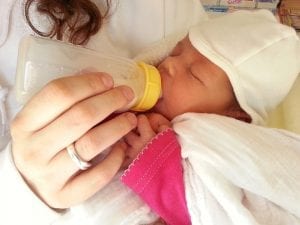
Why Buy A Bottle?
Babies need to eat, but since they can’t eat like how adults do, they eat using breasts, bottle, or a combination of the two. If you’re planning to use formula, a baby bottle would be appropriate, but you still need to consider possible issues like nipple confusion or latching. Investing in a Baby Brezza Formula Pro can make the process easier and more efficient for both you and your little one.
Provide mom with much-needed breaks —Baby bottles can provide you with the rest you need from breastfeeding and do other stuff and chores. First, establish a nursing routine for the baby, and by 3-6 weeks, when they’re already good at latching and thriving, you can introduce a bottle to them now.
Help dad and other caregivers bond with baby — Fathers can use feeding as an opportunity to bond with the baby as it enables them to cradle their little one and make eye contact, an action similar to what a breastfeeding mom does.
Convenience and transportability —there will come a time when the mom isn’t around to feed the baby, so a baby bottle can significantly help during this kind of situation or outings.
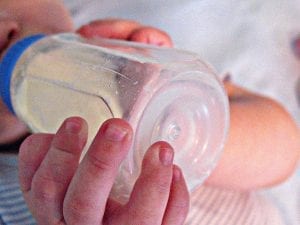

Provide skill-building time for the baby—Bottle-feeding teaches your baby hand-eye coordination, grip strength, and independence because they would need to learn how to hold, tilt, and rotate the bottle.
Formula Feeding Only — There will be times when breastfeeding won’t work out, so bottle-feeding would be necessary.
Trying to find the right bottle that would suit your baby might be more complicated than you think, as it isn’t as easy as getting one off the shelf and paying for it. So what are the best baby bottles available in the market today? When buying a bottle, consider these things:
Types of Bottles
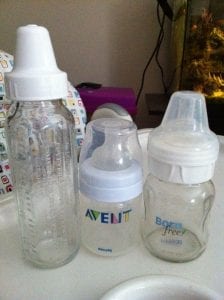

The bottles in this list were reviewed according to their shape, nipple design, body material, vents, and valves.
Bottle Body Material
The Tommee Tippee bottle is plastic with a silicone nipple.
Plastic —This kind of bottle is lightweight, cheap, and portable. You can see the volume using the markings outside the body. They have silicone nipples. There are plastic bottles whose internal venting systems have plastic components. You have to make sure they’re BPA free (read further here: https://www.whattoexpect.com/baby-products/nursing-feeding/moms-favorite-bottles/).
Glass —This one is heavier than plastic but more fragile. It’s easier to clean this and more environmentally friendly; thus, it can cost more than the plastic bottle. Despite its cost, it has remained to be among the best baby bottles for most moms and caregivers. Your baby might have a difficult time holding this, though.
Stainless Steel — This one is an environmentally friendly, easier to clean, and durable option. They are heavier than plastic but are lighter than glass. They also have silicone. However, you might have a difficult time seeing how much milk is left inside.
Silicone — Finding silicone bottles is rare, but there is one out there called the Comotomo. Silicone bottles are lightweight, pliable, easy to clean, and durable as it doesn’t break easily when dropped. It is also scratch-resistant and safe for the baby.
There are many types of bottle body types. Some are shaped so that they’ll be comfortable to hold to the babies while some would have wide neck openings so that drinking the milk and cleaning would be easy.
Nipples
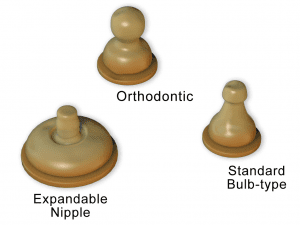

There are two basic types of nipples, but the venting and valve systems of those nipples are similar in variety. While all are silicone, the difference lies in their shapes.
Narrow — Small nipples are often found on bottles with narrow necks, which make the bottle difficult to be cleaned. This kind of nipple makes it difficult for the baby to latch onto but allows smooth transition from the nipple to the actual breast. Narrow nipples don’t have vents, unlike wide ones.
Breast-Like — A breast-like nipple has a broad base and is usually used on a vast neck bottle body. This kind of nipple makes it easier for the baby to latch onto as babies prefer this kind of nipple more. If your baby has previously shown difficulty in latching onto nipples, this would be the right choice.
Vents And Valves
This feature of the baby bottle is used to prevent air ingestion and decrease colic, burping, and spit ups. Some valves and vents are created so complex like Dr. Brown’s that they could lead to leaking and would need you to buy individual brushes to clean them properly.
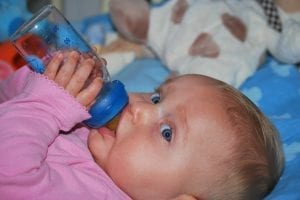

Ideally, glass bottle bodies with a silicone sleeve, a wide neck, and simple parts would be the best. The vent and valve should also be without any plastic components, and the nipple should be something the baby can easily latch to.
How To Choose The Best Baby Bottle
Go at your own pace when finding the best baby bottles for your baby. Don’t get too influenced by other people’s recommendations as the needs of each baby are different.
- Choose Materials
This is your baby’s first time being exposed to possible chemicals, and the said chemicals might even leak to the milk. The order of the most preferred and safest materials would be glass, silicone, and plastic baby bottles.
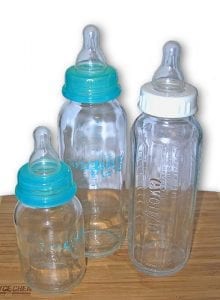

The mentioned glass bottles earlier were thermal and shock material and environmentally friendly so your baby is safe from chemicals that might leach into their food. The Lifefactory glass bottles are lighter than that of Dr. Brown’s Natural Flow Glass. They have silicone sleeves that the Philips AVENT Natural Glass bottles do not have. Additionally, they are not prone to leaking and are more comfortable to hold for babies. A good silicone body bottle would be the Comotomo.
- Choose Nipple Style
You should pick the type of nipple next. Generally, nipples that mimic the breast would be the most appropriate to avoid confusing the baby, especially if you plan to switch the baby’s feeding between bottle-feeding and breastfeeding. This would help the baby retain and enhance their latching capabilities.
Don’t bottle-feed your baby until you have set a nursing routine and your baby already knows how to latch. This usually happens between 3-6 weeks but postpone it if the baby is still having difficulty latching.
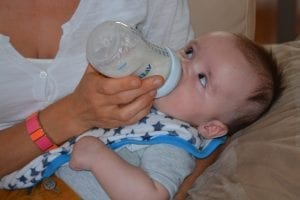

While narrow nipples don’t cause trouble for babies, mound nipples are generally more preferred because it allows the baby to have a natural latch and feeding position. However, it differs from baby to baby, and it would still depend on which one your baby will like. If your baby is showing difficulty in liking any nipple style, start with larger ones first before moving to narrower ones. The Comotomo offers the design that imitates the breast the most. The Lifefactory, on the other hand, has more narrow nipples like other glass bottles. The AVENT is an exception as it has a larger nipple, but it leaks.
The accordion ridges along the bottom side of the Munchkin Latch makes feeding easier, but babies find difficulty with the angle, continually rotating it. The Tommee Tippee, on the other hand, is generally well-liked and budget-friendly, but its plastic bottle takes points off of its desirability.
- To Vent or Not to Vent
The next thing to consider is the vent, and this could be the tiebreaker when measuring the bottle. For valves or vents, a simple one is better than a complicated one because, of course, they are easier to clean – that’s the primary reason. The complicated ones are made of plastic too and could have possible leaking. All the products seem to work the same.
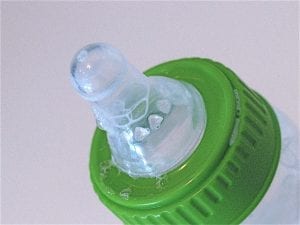

Conclusion
There are now a lot of bottle designs available that make choosing more difficult. There are also features you want to avoid while there are some you would want to get. In the end, it would depend on what your baby would like to get used to – and that’s what you’ll need to pay attention to.
FAQs On Best Baby Bottles
What is the best anti-colic baby bottle?
Among the many popular anti-colic baby bottles in the market, the Baby Brezza Two-Piece Natural Glass Baby Bottle is at the top of the list of favorites. Aside from being an effective anti-colic, it is also easier to clean and brush compared to the other bottles because it only has two parts. Another fantastic feature of the Brezza is its breast-shaped nipple that allows them to drink conveniently and drink milk, not air, from the bottle. Other equally popular anti-colic baby bottles also include Liamo Home Baby Bottle and the Tinukim Hands-Free Baby bottle.
How many bottles should I buy for my newborn?
Generally, parents agree that they need a minimum of 4 to a maximum of 12 baby bottles, but it depends primarily on whether or not your baby is breastfed or bottle-fed. As for the size, you may start with 4-ounce bottles, as they are suitable for the small increments of formula or breastmilk that newborns drink in one feeding (check out more helpful guides here at BabyList).
Which bottles are best Tommee Tippee or Avent?
It depends on the criteria. If you’re looking for something that’s easy and convenient to clean up, then that would have to be Avent. Avent nipples are also softer and human-life. As for Tommee Tippee, its baby bottles have a lot more pieces to wash, and the nipples are relatively harder compared to Avent’s. On the other hand, Tommee Tippee baby bottles are cheaper, sold at $5, compared to Avent, which are priced at $7 each bottle.
Which brand of the baby bottle is best?
According to expert reviews published online regarding the best baby bottles, the Comotomo Natural Feel Baby Bottles are at the top of the list. Although they are a little more expensive than the other choices in the market, you can buy them in packs to get a discounted price. Moms love the naturally shaped and textured nipple, which they say is more convenient for the baby when they switch from breast to bottle. The bottles themselves are soft and squeezable. Other favorite brands of baby bottles include Philips AVENT Natural Baby Bottles, Dr. Brown’s Original Baby Bottles, and Tommee Tippee Closer to Nature Bottles (more reviews and recommendations here).
How many bottles do newborns drink a day?
Two to six-month-old babies are recommended to drink at least 4 to 5 bottles daily, at 4 to 6 ounces each feed. In the middle of this stage, when the baby is about three months old, he may start sleeping throughout the night, so you won’t have to wake him up to feed him.
Is the Avent or Dr. Brown bottle better?
Let’s talk first about Dr. Brown’s Original Bottles. These bottles have a vacuum feeding system, meaning that the baby sucks in less air leading to less colic and stomach problems. As the air is removed, the nutrients from the formula remain in the bottle. Dr. Brown’s baby bottles are all BPA and lead-free, and they are relatively affordable. They’re also among the most durable baby bottles. The Philips Avent bottles, on the other hand, are known for their naturally-shaped nipples that resemble the mom’s breast, which is why babies are easily led on to it after it is breastfed. This is an excellent choice for moms who are mix-feeding. Also, their bottles are dishwasher safe and have fewer pieces to clean. But they are not as powerful in effectively getting rid of the air in the container while feeding.
Do Tommee Tippee nipples fit Avent bottles?
No. Most, if not all, nipples from Avent don’t fit Tommee Tippee and vice versa. Tommee Tippee nipples are too soft, and they collapse at times, causing a mess when feeding. In fact, not all its bottles and nipples are suitable for each other, which is a big drawback. Their anti-colic nipples work only for the anti-colic bottle. Avent nipples also have a flexibility drawback, and they, too, collapse and tear relatively easily.
Are Comotomo bottles suitable for newborns?
Comotomo baby bottles are known for their two anti-colic vents that are conveniently positioned on the nipple to make sure that your infant’s container is well-ventilated. This is so that your baby gets to drink the formula but not the air, which means that there is less colic, burping, spits, and stomach problems. Comotomo baby bottles are a perfect choice for newborns.
Are glass bottles better for the baby?
Glass bottles are more durable than plastic ones. But their downside is that once it drops, it breaks and no longer usable. Also, it may be bulky for newborns and younger babies; therefore, they are not an excellent choice for them. Perhaps plastic bottles that are BPA-free should be used instead of the glass ones for infants and newborns.
How often should you sterilize baby bottles?
To ensure complete removal of germs and bacteria, it is recommended to sterilize your baby bottles at least once a day. It is specifically essential when your baby was born premature, is below three months old, or has a weak immune system. When they grow older, sterilizing may not be done daily, especially if the bottles are cleaned and washed well after every use.
Last Updated on May 10, 2023 by Bry Roquero
DISCLAIMER (IMPORTANT): This information (including all text, images, audio, or other formats on FamilyHype.com) is not intended to be a substitute for informed professional advice, diagnosis, endorsement or treatment. You should not take any action or avoid taking action without consulting a qualified professional. Always seek the advice of your physician or other qualified health provider with any questions about medical conditions. Do not disregard professional medical advice or delay seeking advice or treatment because of something you have read here a FamilyHype.com.